
Buffer CultureLab Episode 5: Skinny Jeans and Snake People (with Kanyi Maqubela)
Former Director of People @ Buffer
I can’t believe we’re on Episode 5 of the podcast! Every time we get together for Buffer CultureLab it is both fun and educational, and this week is no exception.
On this episode Carolyn and I talk about Millennials at work, and then welcome Buffer investor Kanyi Maqubela, who is a partner at Collaborative Fund. It’s a very different kind of investment fund that looks beyond traditional investing criteria to think about things like creativity, values and culture.
Language alert! Things get a little colorful in the second half of the show ?
What you’ll learn from this episode:
- What generation you belong to (we have a chart!)
- What a Millennial mindset is (and how to get it, if you want)
- What Millennials want in a workplace
- What it means to use values as a competitive weapon
- The challenges and benefits of transparency from a business standpoint
- How Kanyi and Collaborative fund define what “social good” is with their investments
- Which U.S. demographic is the most predisposed to being a founder
- The specific startup conditions at which diverse team outperform homogenous ones
- How the tech community is similar to the hip hop MC community
Stuff we talk about in this episode:
- The Snake People plugin, which replaces every instance of the word “Millennial” with the phrase “snake people”
- Brian Fanzo, aka iSocialFanz
- How to figure out Snapchat
- Hiten Shah’s blog
- Collaborative Fund
- Buffer’s transparent funding round (that was concocted in Kanyi’s office!)
- GOOD Magazine
- The documentary Truth in Numbers, which is the story of Wikipedia
- How psychological safety affects workplace culture and diversity
Get in touch!
- Connect with Kanyi Maqubela: Twitter | website
- Connect with Carolyn on Twitter
- Connect with me on Twitter!

Caro & Court chat: Snake people, hand-holding and Millennials at work
Courtney: I think we might have created the most Millennial workplace ever. Basically everything that Millennials want at work is what we do at Buffer.
Carolyn: Yep. I also was researching for today and I had a similar experience, like, “Oh, okay, this makes sense why our turnover is low and people seem really happy and”-
Courtney: Why we’re populated almost exclusively at this point by people who fall into the Millennial age range.
Carolyn: Yeah. I would be interested to unpack that particular statement.
Courtney: Okay.
Carolyn: The Millennial age range.
Courtney: Do it.
Carolyn: Mostly because … I’m going to borrow a phrase from Brian Fanzo, who goes by iSocialFanz, and he’s a longtime friend of Buffer and just a cool person who is-
Courtney: Indeed.
Carolyn: Yeah, he’s awesome. He often says, “Millennial is a mindset,” and I really believe that and I’m curious, because I know you … Or I believe. I think I know that you
don’t usually identify with the Millennial. Do you agree with that statement or how do you fall on that scale?
Courtney: By the letter of the law, not that there’s a law guiding what we call Gen X or Millennials … Technically, I am a Gen X’er in a company of mostly Millennials, and I think through osmosis or something I’ve become much more Millennial in mindset. I do agree with that statement.
It might be handy for us to just say real quickly what the Millennial guidelines tend to be, and I googled around a little bit to see what they were, and it looks like if you are born sometime between 1980 and 2004 … That’s the sort of largest age range and there are some little differentials there. 1980 and 2004. If you’re born within that time, you are technically a Millennial. Does that include you?
Carolyn: It does, and that is a huge range.
Courtney: It is pretty big, yeah.
Carolyn: Are you saying that that … People born in that whole range count in one
generation?
Courtney: Oh, wait. I pulled a cool chart so we could look at it. Let’s see. Greatest Generation, looks like 1930 to 1945. Gen X is 1965 to ’84. Millennials is one of the biggest swaths of time.

Carolyn: I want to protest to that, because-
Courtney: Do it.
Carolyn: The world and the technology and the experiences change so quickly that 24 years … I mean, even like a ten year gap in there is a really different experience.
Courtney: Yeah, the difference between someone who’s born in 1982 and ’99 would be entirely different. Or maybe not entirely different. Some things … I think the sort of unifying aspects that people point to are access to computers pretty much your whole life. Would that be the case for you, generally speaking? You kind of grew up with technology?
Carolyn: I did.
Courtney: Yeah. I was talking to my mom about this over the weekend and was sharing some of the inclusivity and diversity stuff that I’m up to at Buffer, and was saying one thing that’s really tricky for us is to think beyond Millennials and get viewpoints that are of diverse age ranges. She said, “Courtney, old people, we just can’t learn this stuff. It’s just beyond us. We didn’t grow up with it the way you did,” which, you’re shaking your head vehemently.
Carolyn: I call shenanigans on that. I do not believe that in any way. Personally because I just don’t believe that that’s true from a perspective of human learning. I also personally have not seen that to be the case.
Courtney: Yeah.
Carolyn: We as a company, as Buffer, have so many incredible customers who are starting businesses in their sixties and seventies, and my last job I saw that and my own father is the techiest … He and I still are neck and neck in terms of who out-computers the other. Yeah, I don’t think that’s true.
Courtney: I think for her it feels … You know when every new technology comes along, like Snapchat, I think you’re like, “Oh, I don’t know how to use Snapchat. I’m just going to let that one go by.” If you let enough of them go by, suddenly you’re looking at a world that feels very foreign to you, and it almost feels like I’ve lost my way to get back. Which is why I was very keen to figure out Snapchat. I was like, “I don’t want to get old.”
Carolyn: Yeah, so Snapchat is a particularly interesting one because … I have never been intimidated by a piece of software.
Courtney: Good for you.
Carolyn: Until Snapchat. I’m going to unpack that. I generally find that if you just push enough buttons and look through the settings and that kind of stuff, you can basically learn almost everything you need to learn.
Courtney: Yeah.
Carolyn: Snapchat is one of the ones where … There’s a sort of argument/conspiracy that they make it-
Courtney: It’s on purpose.
Carolyn: Yeah, purposefully not easy to figure out so that it intentionally creates very in and out crowds of people who get it and people who don’t.
Courtney: To flummox the Gen X among us.
Carolyn: Totally. I mean-
Courtney: Only the Millennials get it.
Carolyn: Yeah, or even-
Courtney: Even younger, I guess.
Carolyn: Yeah, what’s the one that comes after Millennial?
Courtney: I think they’re still naming it. We haven’t voted yet.
Carolyn: Yeah, okay. Yeah, I think even Millennials are sort of left in the dark in a lot of ways with Snapchat. I don’t know. As soon as you decide you want to learn it then you can learn it, but it is … That is the first one where I’ve gone, “Okay, unless somebody taught me that, I wouldn’t have known that.”
Courtney: Yeah, and I think you’re the one who taught me all that Snapchat, so thank you for that.
Carolyn: When you brought up this topic of Millennials, it was so interesting to me to hear you say that we have generally created a company that is stereotypically and according to all the hundreds of articles about the things that Millennials want and like, like company purpose and flexibility and opportunities to grow and learn and things like that.
Courtney: Yeah.
Carolyn: I do think we have very much created that environment, and I wonder partially if that’s because our co-founders also would fall into that age range.
Courtney: Definitely. Yeah, I think that’s a great thread to dig into because I have had the experience of being quote-unquote “managed” by Millennials in that our founders at Buffer are of the Millennial age, and I’ve had the experience of talking with a lot of friends who are not sort of in the startup life who have more corporate situations, and they have a lot of interesting things to say about managing Millennials.
I think there’s a stereotype that Millennials … That they don’t have the same goals around work that older generations do. I think they’re much more willing to switch jobs for a greater degree of happiness, whether or not that results in a bigger paycheck, and what they want out of work is just a little bit different.
Huge generalizations here; not every Millennial is alike. But I think when you have the experience of managing them within a corporate structure, it probably feels a lot different than joining a team that has that mindset from the top down.
When you prioritize flexible work, when you prioritize work with purpose and having fun at work, it’s not at all difficult to manage Millennials. You get people getting at their best capacity. Again, huge, broad strokes.
Carolyn: I’ve heard lazy. I’ve not found that to be the case. I’d be curious to hear from other people. If anybody would like to weigh in on this, I would love to hear whether people who have managed Millennials in this same timeframe as Gen X’ers or Boomers or any other generation or whatever the younger generation is, if they have found that to be the case.
I’ve also heard the sort of trophy aspect where we all got trophies for participation, which I definitely had that experience.
Courtney: That means you need more workplace affirmation possibly?
Carolyn: Constant validation. Yeah.
Courtney: Do you feel that’s true?
Carolyn: For myself, personally, a little bit, yeah. I do think I wither up a little bit when I know I’m doing good work but I feel like either no one else knows or feels that way or … Things are different now. You do change jobs a lot more. People get fired more easily. You don’t just work for the same company forever. It’s not about recognition. It’s about, “Hey, I want to make sure that people know that I’m carrying my weight.”
Courtney: Yeah. That’s also the human condition. It doesn’t seem like only Millennials would want to be recognized for doing good work.
Carolyn: Totally.
Courtney: I feel like everyone wants to be recognized for doing good work.
Carolyn: Yes. Yes.
Courtney: I’ve heard hand-holding a little bit, and I think another way to phrase that in a more positive way would be: They want a lot of feedback and hands-on interaction, which is a great way to nurture someone to become a better employee and leader on the team. I don’t know, just two sides of looking at it, I guess.
Carolyn: Yes. That’s really interesting that you say that because one of our sub-bullet points of our values is we share early and often. That is a little bit like the positive version of hand holding in that … Yeah, we don’t want anybody on the team to spend a whole lot of time going down the wrong track or wasting time on a direction with a project.
Let’s talk about it at stage one. Joel, our CEO, talks about giving 10% advice, 30% advice, and 80% advice. I think he got that concept from one of our advisors, Hiten Shah. The idea is like … Hiten often says, “Do you want thirty percent advice or eighty percent advice here? How far along are you in this?
Because I can only do so much for you if you’re at eighty percent, but if you’re at thirty I can really give big feedback.”
Courtney: It’s that lean idea? That lean startup-
Carolyn: I think so. I think so. Yeah. Yeah, there’s like this lack of a big reveal. You don’t want to have a big reveal of a project that you’ve been working on for three months and have it be way off.
Courtney: Yeah. That makes sense to me as a … All the things that Millennials want in a workplace, quote-unquote, make sense to me that everyone might want in the office. Regular feedback, ability to be themselves, flexible work, knowing why you’re working, what the purpose is, having fun at work. All those things don’t seem too out of the realm of possibility for a lot of people to want.
Maybe it’s just now more realizable that more people can work this way, and maybe there’s a little bit of resentment possibly, that people of other generations maybe didn’t get to have fun at work. You just had a job and you showed up every day until you retired and that was pretty much it. Maybe it’s more about the evolution of work and each generation kind of wanting what the next one gets.
Carolyn: My sense is that it might have a lot to do with identity and how closely you tie your identity to your job. I feel like I and my general circle of family and friends of my generation and age group and mentality do put a humongous amount of identity into work. I wonder if that is an evolution of work or if that’s always been the case.
Courtney: I do feel like work has expanded in my lifetime from what I saw my parents do, which was very compartmentalized. There’s work and then there’s home.
Technology has a lot to do with it, as you know. You bring your email with you everywhere through your phone if you want to go that route, and a lot of people do. You stay connected on vacation sometimes because you don’t really know any other way. Work has become such a larger aspect than maybe it used to be of people’s lives.
Carolyn: Mm-hmm (affirmative). It almost fills in all the holes.
Courtney: What else could be your identity if work is almost all that you are now, in some ways?
Carolyn: I would be so, so interested to hear from others on this topic from Millennials, X’ers, Boomers alike, and whatever comes after it. We would also like to hear what you could like to be called if you’re in the generation after that.
Courtney: Yeah.
Carolyn: Send us your best.
Courtney: When I was sharing this topic idea with the team, I peeked into the document where I did a little research and I saw that Emily, one of our engineers, had installed the Snake People plugin, and every instance of the word “Millennial” was replaced with “snake people”.
Carolyn: That is so freaking funny.

Courtney: If you’re not familiar with the Snake People plugin, you add it … It’s a Chrome extension and basically it does just that. Every mention of “Millennials” is changed to “snake people”. Your headlines become really funny things like “Navy seeks to adapt training for snake people”. So thank you, Emily, for giving me a hilarious laugh this morning.
Carolyn: Hilarious. So good.
Kanyi Maqubela: Values as a competitive weapon
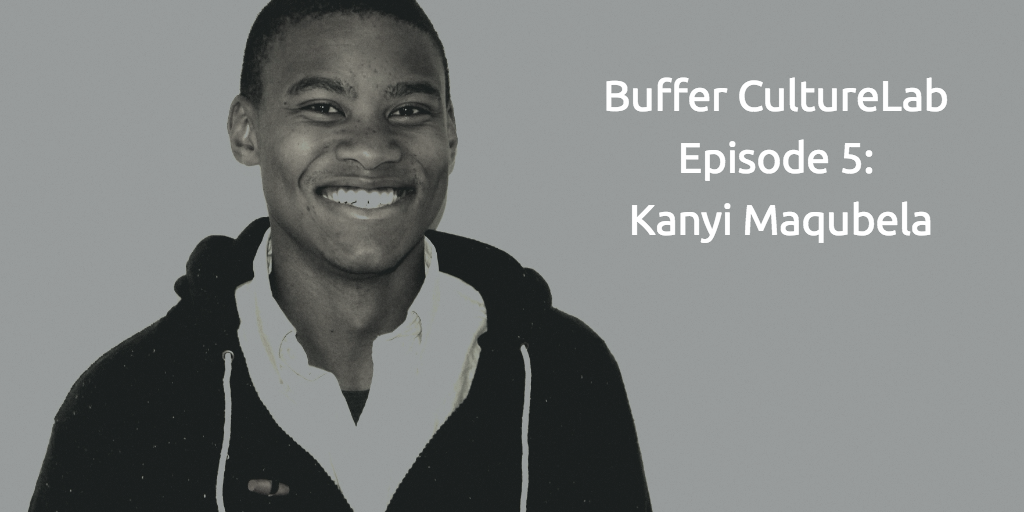
Courtney: Buffer basically freaked out when we discovered Collaborative Fund. In 2014 our founders, Joel and Leo, were looking for investors for Buffer’s totally transparent funding round, which is unique enough as it is. Then Buffer found Collaborative Fund. How they think about investing is completely different than any other fund that we have heard of, and they ended up leading Buffer’s funding round. In this next segment, I got the unique opportunity to interview Collaborative Fund partner Kanyi Maqubela about investing at the intersection of good and profit.
Courtney: You are, in fact, a Buffer investor. Is that right? Is that the right way to say it?
Kanyi: I am indeed, yes. I am the lead investor on Buffer, as a matter of fact.
Courtney: Okay, I didn’t even know that.
Kanyi: Yes. I led the Series A when you did that big transparent round that was concocted in our office.
The story behind Collaborative Fund
Courtney: So exciting, and because of transparent email I was able to sort of lurk on those emails and get to know a little bit about Collaborative Fund, and it seems like a pretty special place that seeks out very specific types of business for very specific reasons. I’d love to hear a little bit more about that.
Kanyi: Sure. It’s both very specific and also very broad, by which I mean we’re not constrained by SaaS or healthcare or consumer Internet or any of the traditional verticals that one might use to describe a company. We are actually more interested in the cultural implications of a human company and the cultural impact of a company, should it become massively successful.
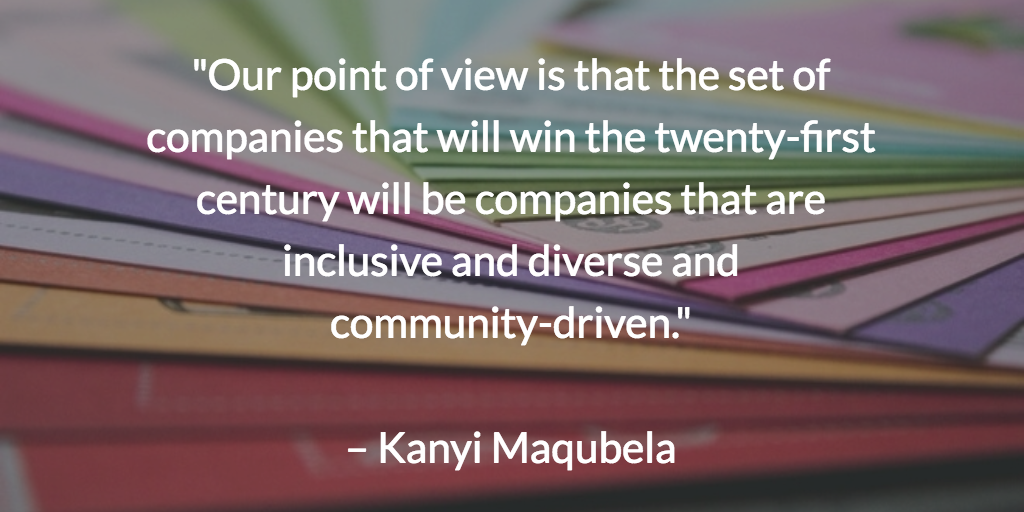
Our point of view is that the set of companies that will win the twenty-first century will be companies that are inclusive and diverse and community driven and if it’s a consumer product, that it trades on the power of local and believes in being organic and natural and if it’s a digital product, that is transparent where there is accountability layers that are accessible for the consumers, where stakeholders have aligned in interests, where values are used as a competitive weapon, and we think that set of criteria can be applied across industry. In that way, it is very specific but it’s also very broad.
Courtney: Wow. How did you come up with this set of guidelines that help you choose the strength of a particular product or service?
Kanyi: You know, it’s been an evolution. My partner Craig who founded the fund, and I joined him a few months later, had previously been president of GOOD Magazine, which was a media company in Los Angeles.
Courtney: I loved that.
Kanyi: Oh, cool. Good. Thank you. We’re part of the GOOD family in that way, and the tagline for GOOD at the time, and I think it’s still the same, was “for people who give a damn”. They were basically just trying to tell a story about how they felt like there was something in the zeitgeist and that the most dynamic, engaged, smart creators and, frankly, young people more generally, were not just interested in greed. It wasn’t ambitious enough. They weren’t just self-interested. It wasn’t social enough. They were interested in purpose and in meeting and in passion, and so GOOD was celebrating this story, and Craig felt like there was an investable thesis to bring to bear there.
That was the biggest part of it. Then the other parts … Because Craig was actually the producer of a documentary called Truth in Numbers, which was the story of Wikipedia. In the telling of that story his mind was blown by the fact that we could create this extraordinary body of work in such an amazingly short time for so, so, so, so, so, so little money on the basis of collective effort.
That combination made him realize that the future is going to look very different and that investing in that ethos and that je ne sais quoi was where he wanted to focus his energy, and so that was the why. Since then we’ve been fine-tuning it and refining it and reacting as the world and the market has changed so that we can try and keep it sharp.
Courtney: So interesting. Is this a normal thing to do? Are there a lot of companies that have a guiding philosophy or is this a pretty special, kind of newer way to look at investing?
Kanyi: Again, I like duality and I suppose … It’s old and new. It’s old in that there are thesis-driven funds, and thesis-driven funds are … Not only are they not old, but there’s a rich history of them. Some funds are specifically focused on healthcare. Some funds are specifically focused on enterprise software. Some funds are specifically focused on network effects. There’s been great success in that level of specificity, and there’s also a rich history of impact investing where funds lead with a theory of change that’s fundamentally about how to make the world a better place and trying to invest in that theory of change.
It’s new, I would argue, in that those two things have traditionally not been co-mingled, and so the so-called traditional VC’s who invest with a thesis have almost never been considered impact investors, and the impact investors have traditionally been considered a either subsection of this asset class or a separate class entirely.
The belief that social impact can be a thesis for commercial competitiveness is somewhat new, and it’s our belief that not only will we be able to compete against the status quo venture capitalists but that we’ll be able to beat them, because values are a lot more resilient and are a lot more appealing to consumers than almost any other metric you can qualify on.
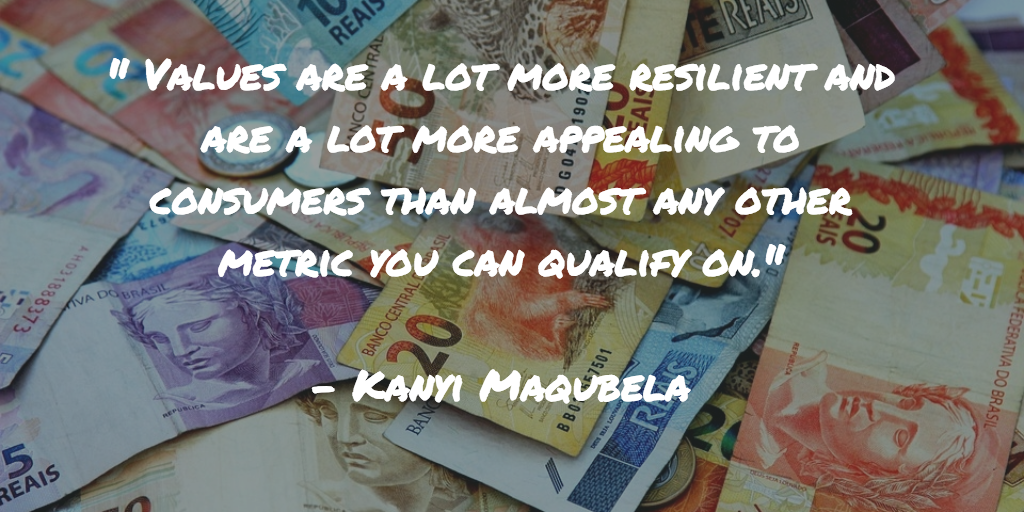
How does Collaborative Fund choose its investments?
Courtney: Wow. You said something earlier that I thought was such a great phrase, like “values as a secret weapon” or something like that, and … Do you sort of know it when you hear it? When someone comes in to pitch you, do you have that sort of spark moment? How does that manifest itself?
Kanyi: I guess it’s sort of like, if you’ll allow a strange analogy, kind of how the FCC defines porn. It’s deeply subjective and it’s also a Rorschach test, right? If you were to ask a CEO whether they thought that their vision for the future was impactful, I’m sure 99 out of 100 of them would say “heck yeah” and, frankly, would be offended to consider that it weren’t.
As a result it can be something of a shifty target in that way. We have our own internal point of view and biases and cultural orientation which guides us, but it changes as the companies come.
We hadn’t thought of ourselves as the type of firm to invest in enterprise SaaS until we met Joel and Leo, and when we met them we thought, “Oh, aha. There could be a way of creating social impact not just in the content of your business but in how you run the business itself, and that’s actually something we’re really excited about, too.” You have to be somewhat reactive because you never know where and how people are going to innovate.
In that way we are not too prescriptive about what we want in the market and you have to be a little bit reactive, but we just try and put out into the universe: “Do you have values? Is your brand really beautifully designed but is the story just an inspirational one?” Then see what happens from there, you know.
Courtney: Are there enough companies that are working this way, innovating this way? It sounds like there are because you’re still around and doing pretty well, I would think.
Kanyi: Well, it’s a good question. It’s a really good question, and the answer is: “I don’t know”. The more nuanced answer is: “It depends on what category you’re looking in.” To unpack that a little further, if you look at consumer packaged goods and consumer products, for example, the answer is heck yes. The number of natural, local, organic, one-for- one, really great social mission granolas and skin creams and T-shirts that you can buy have crazily proliferated. You can’t turn left and walk halfway down the block without running into one of those, and so clearly in the consumer space.
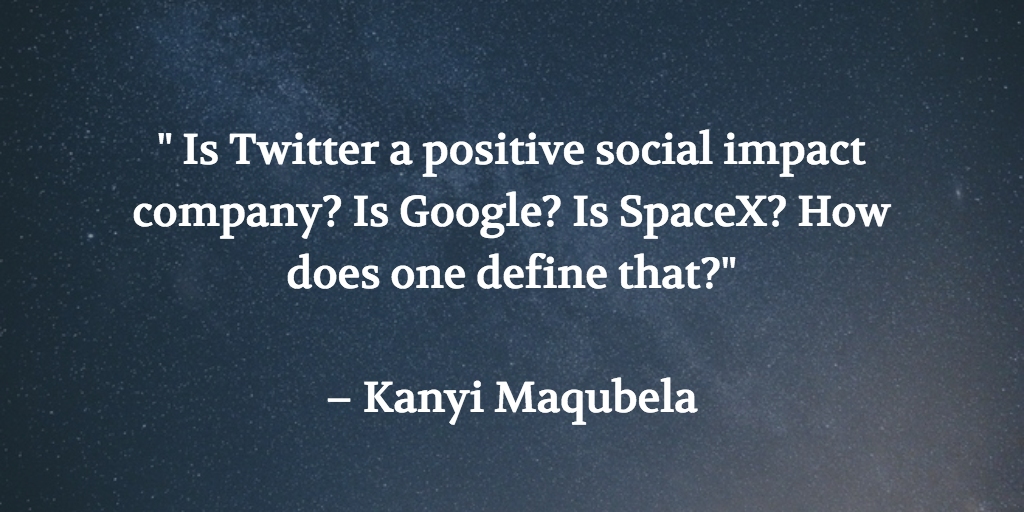
In this traditional tech space, it’s a little bit different, I think, because: Is Twitter a positive social impact company? Is Google? Is SpaceX? How does one define that? It’s still emergent, and the lexicon and even the lexical bounds of what constitutes positive impact in the digital world are still emergents, and it’s still a new phenomenon in the Silicon Valley. We’ve had a bit of that scaffolding that’s been built around the industry and I think we’re going to start to fill that in as time goes on. At least I hope.
Will consumers ever be skeptical of values-driven companies?
Courtney: I wonder if there’s a tipping point where … I come from a marketing background. That’s what I had previously been doing at Buffer, and everything eventually kind of wears out in marketing. If you try one tactic, it works for a while and then people sort of get inured to it and you have to try something new, so we’re always experimenting.
Values, to me, never really seemed like they were a marketing element, but I’m sort of riffing off what you were saying about granola and organic clothes and … Is there a tipping point where consumers and the public in general is kind of skeptical about values-driven companies? Or maybe we can believe better in human nature and that that will always appeal to us.
Kanyi: Well, that’s a really good question and I think that we’re already in that time. I think that right now, because we have so much access to information as average consumers all over the world because of the Internet, consumers are really darn sophisticated. Part of being really sophisticated is our bullshit filters are really fine-tuned.
We have such little tolerance for when a brand tries to be opportunistic. We can smell it from a mile away. When a company is inauthentic in some story that they’re telling or some aspect of how their selling their product, people turn their nose at it.
I think that’s only intensifying because we’re so sophisticated, which means that if you’re faking it you’ll probably get found it eventually. You have to live it, and if you live it then consumers can smell that, too, and they’re drawn to that, too. I think we’re already in that and it’s part of why I believe that values are a competitive weapon, is because consumers are looking at the whole picture.
Increasingly we know what the full supply chain is for a physical product that we get. We know what the personal background is of the executive team when we’re using a digital product or using a social product. The average person on the street knows exactly who the CEO of Facebook is and probably knows about how old he is and what he looks like.
There’s an extraordinary level of transparency that we’re now entering for a business standpoint, which means that you have to keep it real or else they’ll find out. They won’t let you bullshit, right? I think that’s a good thing, and whether or not it’s a good thing, it’s certainly an inevitable thing. Right?
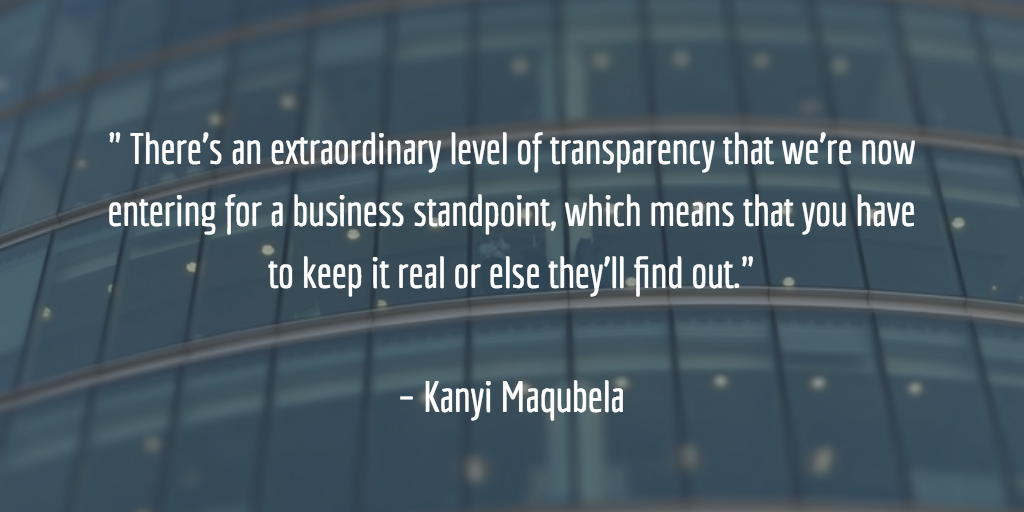
Courtney: You can only use it to a certain point. If you actually believe in it, that will shine through, and if you don’t, that will probably be found out.
Kanyi: You have to live it or else you’ll be called out. That’s my point of view.
How can we get more diverse founders into the ecosystem?
Courtney: You mentioned two of my favorite words, “inclusivity” and “diversity”, as far as maybe an element of companies that you choose to work with or an element that you consider strongly. Obviously a very hot topic right now, in technology sector in particular. How do we get more voices, more experiences, more backgrounds into positions where they can found things and make products and make things happen?
Kanyi: Well, the first answer to that specific question is: If you look proportionately at the demographics of the United States and which demographic is the most predisposed to being a founder, you’ll find that it’s black women.
Courtney: Awesome.
Kanyi: I think “necessity is the mother of invention” is the phrase, and black women have been left out of so many conversations and have been left out of so many of our institutions that it is only natural that they would over-index in entrepreneurship, because they have to.
The first answer is: People of color and people who have been left out already are creating more. The broader answer to the deeper question is: It’s got to be all hands on deck. I think that there isn’t a magic bullet. I think that limited partners need to be investing.
The institutions that invest in venture funds need to be investing in general partners, need to be investing in VC’s, who are proportionately representative of the demographic they serve, and so need to be funding fifty percent female VC’s, need to be funding black and Latino VC’s, need to be funding Asian women and Latino men and these demographics that have been so underrepresented thus far.
We VC’s at our partnership tables need to be backing the black women CEO, need to be backing the poor, rural, white male founder. Right? Because we have phrases like “fundable” and phrases like “backable” and “social proof”. We have all these codes and this language that we use to create structural barriers, some of which we’re not even aware of, and so we need to be better and need to be more vigilant.
CEO’s themselves need to invest in software and invest in HR practices that encourage them getting out of their own way, so avoiding their own cognitive biases. Then the pipeline issue. We need to encourage more women to get into STEM and more girls to get into STEM earlier, and more people from underserved backgrounds to get access to resources and access to opportunity and access to education.
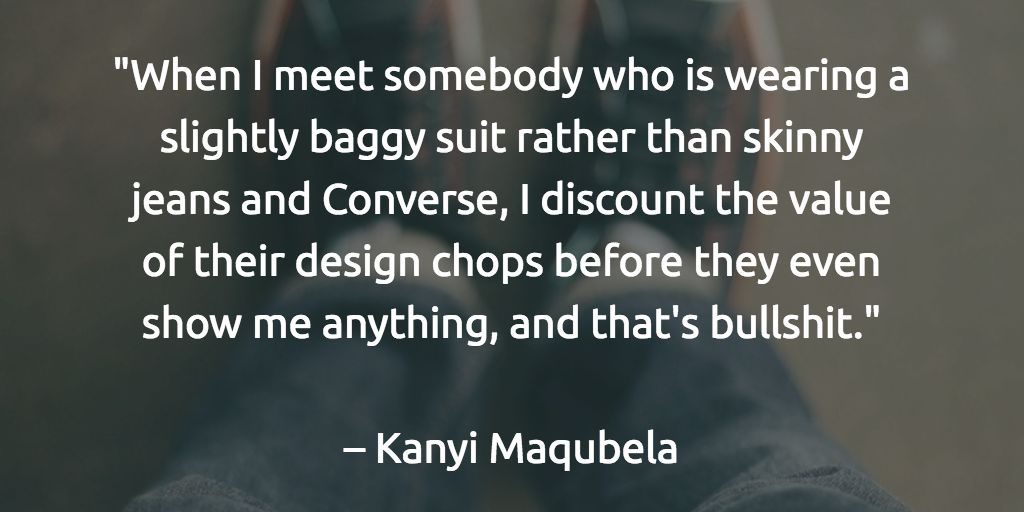
It’s an absolute systemic challenge. It’s like saying “how do you solve healthcare”, right? You need to do everything better, but my personal responsibility, I think, is to be relentless in my commitment to it in every action that I take and then sort of live the change I want to see, and then the second piece is to be honest with A, myself, but B, the community.
I’ve got awful cognitive biases. If somebody worked at Google and is a twenty-eight-year- old white male and has a recognizable last name, they’re more fundable in my current peanut brain and that’s awful, and it’s a huge problem and I need to be better about it.
When I meet somebody who is wearing a slightly baggy suit rather than skinny jeans and Converse, I discount the value of their design chops before they even show me anything, and that’s bullshit.
Then on the other hand, there’s so many of these things like: I don’t want to hire or support or promote a person just because of their insert-demographic- trait-here, which we all have acknowledged as somehow being wrong and yet … How many times give somebody the benefit of the doubt because they went to Stanford?
Because their first name is John? Because they wear a watch similar to mine? Gosh, if somebody was like, “Oh, I don’t want to hire him just because he’s black” …It’s like, “How many people have you hired just because they’re white? Goddamnit.”
Seriously, and so I think that being honest about it and being comfortable being courageous about the problem and just addressing it for what it is, is important at all levels because nobody wants to be villainized and nobody wants to be demonized and to be made to be defensive.
If we can all just be honest about the fact that this is a systemic problem, the systemic bias exists among all of us, and it’s bad business. The same way that putting Jackie Robinson in baseball made baseball better is indeed true in other fields. It’s just cold, plain logic, right? I think that finding a way to make it as unemotional and un-antagonistic a conversation and as transparent and direct and clear a conversation as possible at every point in the value chain is my approach.
Courtney: So much to unpack there. A lot of good stuff in that answer. That was wonderful and so many … It’s like five thesis papers right there on change we can make.
Kanyi: I guess the other point I’ll add there is: There’s plenty of research that shows that diverse teams out-perform under psychologically safe circumstances, and there’s a weird challenge with that as it relates to startups because right now, I think most startups aren’t psychologically safe because they’re just trying to survive.
In fact, they’re not psychologically safe because they’re at existential risk of death at more moments than not. Can we create conditions whereby a team of three that’s just eating ramen and living in their parents’ basement and trying to figure out the way to survive … How they can be intentional about culture and intentional about resolving our unconscious biases?
That’s a really hard problem. That’s a functionally hard problem to solve, and so I don’t think that there is a simple silver bullet, even in the context of hiring, to say, “The research is this so why aren’t you doing it?” It’s harming that. It’s okay for these things to be hard. I think design challenges that are hard are exciting, and the hard ones are the ones that attract the really smart people, and so I think that being okay with that and having more of a fixer attitude and less of a blaming attitude are useful. Being less antagonistic, I think, is useful.
I’ll call somebody out because I call myself out and I try and make it such that I’m call-out- able, and so I hope that’s something that we can all encourage.
New York vs. San Francisco
Courtney: You’ve been part of the startup and innovation scene for quite a while in a few different places. I know you lived in the Bay Area for a decade or so before moving to New York. How are those cultures similar and how are they different?
Kanyi: They are super different in almost all ways but one, and the one way in which they are similar is the tech community is sort of like the EDM DJ community or sort of like the hip hop MC community. We’re always remixing and sampling and collaborating and borrowing and stealing and beefing, but we’re all in it very, very, very much together.
It’s not like there is one band here and one band here, and maybe one band covers the other band but that’s the extent of their interaction. No, no, we’re all always intertwined. It’s supportive in that way.
Gosh, the number of startup CEO’s who just made the transition from a ten-person team where they know everyone’s name to 100- or 75- person team where they barely know everyone’s name or they’ve just started to not, who are excited to be older siblings to new founders that are just at the 30-person person team stage or still trying to figure out if they have a shot at building anything …
There’s so much of that type of intergenerational support that happens within the ecosystem, even though it is more insular than people give it credit for, particularly the venture backed aspect of it. Once you’re on the inside, it’s fabulously collaborative and everybody is in a either cooperative environment or an environment of “coopetition”.
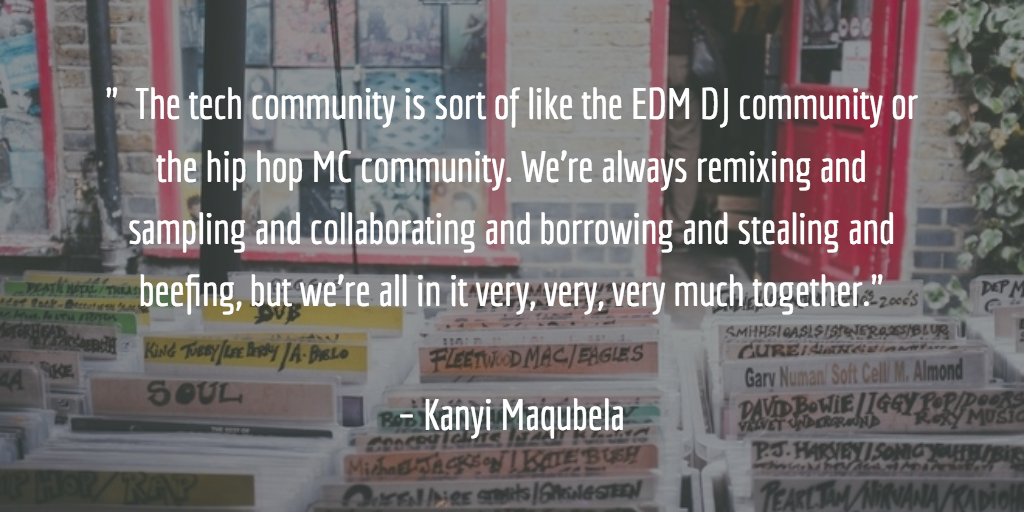
Even if they’re competing, they’re still in constant communication and they’re sharing stuff and then talking about it, and I think that’s wonderful. There’s no silos. It’s like amoeba walls.
Outside of that, New York and San Francisco are wicked different. New York is extremely diverse. It’s one of the most diverse cities in the world in terms of race, yes, but even it’s in terms of character and geography and sensibility. There’s so much going on here.
It’s also a major international global city and, with utmost respect to San Francisco, I don’t think I would call it that. It is a place where there are four or five massive industries that have real hubs here. As a result, it’s dynamic. It’s utterly dynamic. Which is a wonderful thing.
San Francisco has less of that. But another thing about San Francisco that I love, which is that it is a future-facing city. There’s such insane and, in some cases, untethered-from- reality optimism about how the future can be, and a little bit of unreal optimism is kind of what you need to build the future. You kind of have to live in it and … Needless to say, that’s impossible, right?
There’s something about that which I find kind of wonderful. People in San Francisco, I always say, are more curious what you think your kids and grandkids are going to do, whereas in New York they want to know what your parents do. There is that difference which makes it a pretty wonderful place.
Lightning round with Kanyi!
Courtney: I thought we might do a real quick lightning round, if you’d be up for a few random questions.
Kanyi: Yep. Hit me with them.
Courtney: All right. What’s the last thing you did that got you out of your comfort zone?
Kanyi: Last thing I did that got me out of my comfort zone, gosh. I cried at work.
Courtney: Oh, wow. That’s a good one.
Kanyi: Yeah. That’ll do it. Yeah. Did that get me out of my comfort zone? You’re damn fucking right it did.
Courtney: That is a good answer. Where do you do your best thinking?
Kanyi: Shower.
Courtney: Shower. Such a good answer.
Kanyi: Definitely the shower.
Courtney: How do you make the people around you better?
Kanyi: Well, I show them love. I’m a hugger. I’m kind of a touchy, feely type dude. I think the best way to give someone courage is to show them love, because when your heart is full of love there’s no room for fear.
Courtney: Excellent answer. I love that. Cool. Well, this was a pleasure. So much fun.
Kanyi: Thank you. Thank you for doing it and please say hi to the rest of the Buffer crew.
Courtney: I absolutely would love to.
Try Buffer for free
140,000+ small businesses like yours use Buffer to build their brand on social media every month
Get started nowRelated Articles

Check out the 25 best podcasts for creators, marketers, small business owners and anyone looking to up their social media.

In this article, we dive into podcaster and Bufferoo Phill Agnew's strategies that can help you grow an engaged audience, no matter the format.
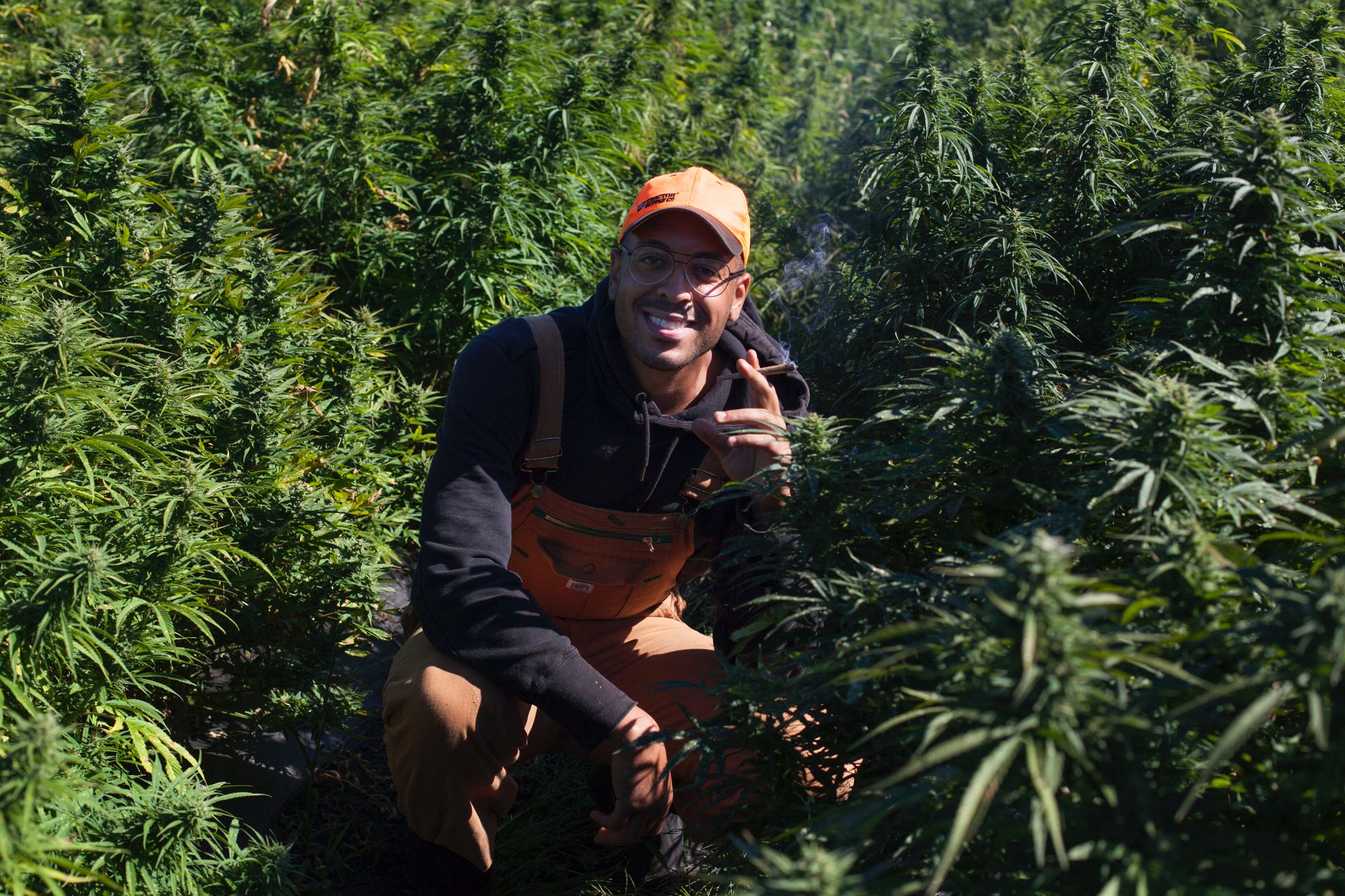
Damian shares his journey from hemp farmer, to teacher, to business accelerator leader, and the economics behind why he focuses so hard on encouraging people to become hemp farmers.